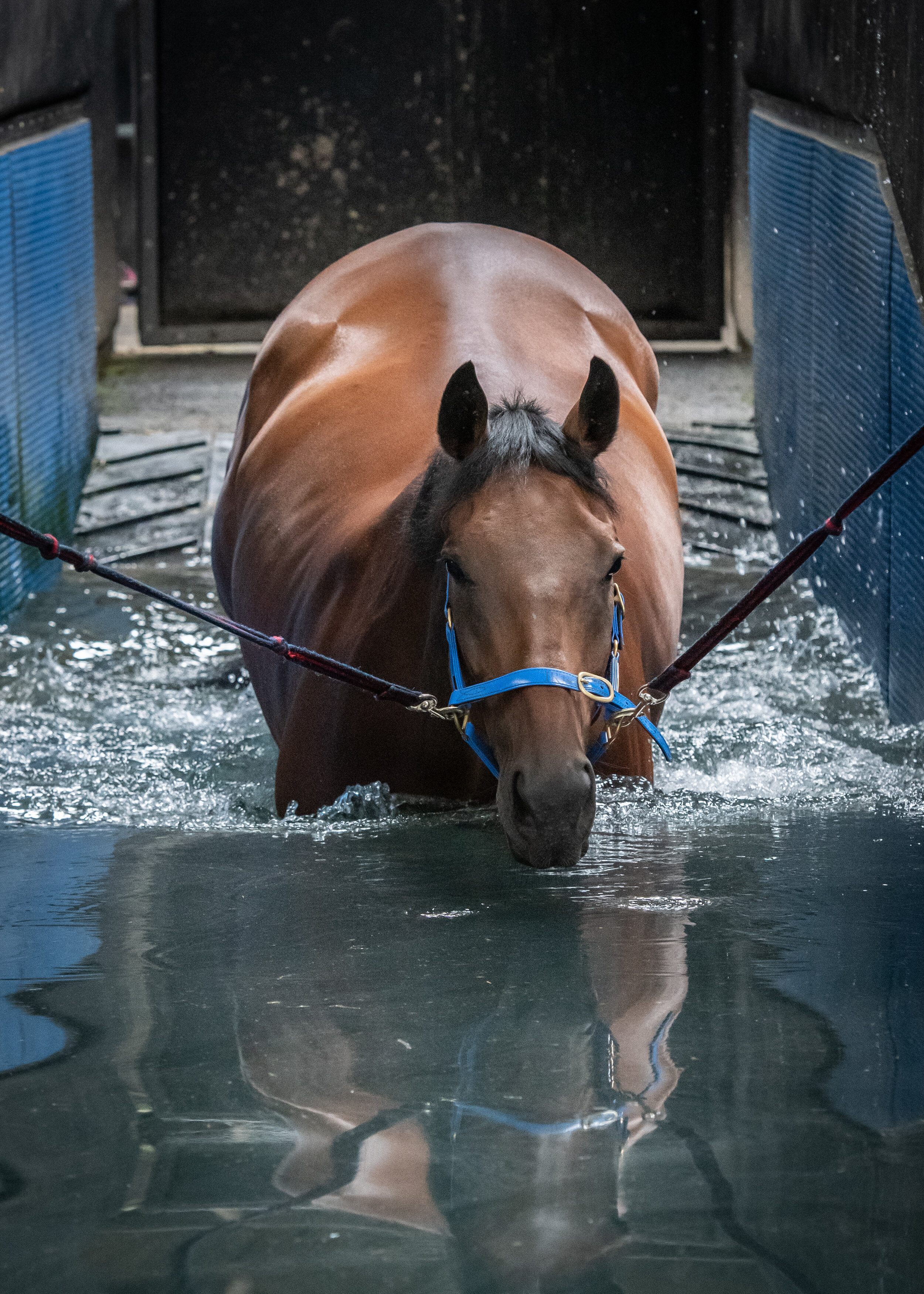Hydrotherapy for performance - the benefits of water based conditioning - hydrotherapy as a mechanism for enhancing performance in the racehorse
What is hydrotherapy?
The historic use of water for therapeutic benefit in the equine industry has taken a leap in development in recent decades, from the humble use of cold hosing a swollen limb through to the development of water treadmills and water walkers for injury rehabilitation and performance development. Cold hosing and other forms of cooling localised areas of the body is more correctly termed cryotherapy—meaning, it aims to harness the benefits of reduction in temperature to treat mainly acute and oedemic injuries. By reducing temperature of the local area, for example, a distal portion of a limb, several key functional changes occur. First, local blood flow is reduced. This is especially useful if an open wound is involved; the precapillary sphincters constrict and direct blood away from the area. Secondly, there is evidence that nociceptors, involved in the perception of pain and sensory receptors located at the end of peripheral nerve endings can be temporarily suppressed with local application of cryotherapy. Following a brief summary of cryotherapy, this article is going to focus on hydrotherapy as a mechanism for enhancing performance in the racehorse, focusing on the specific parameters of fitness that can be targeted and thus improved.
• Fundamental properties of water
There are several fundamental principles of water that can be used as a recovery tool to facilitate optimum rehabilitation and ongoing performance improvement. When immersed in water, or made to move through water, the horse’s body, like the human, encounters a medium for which it is not designed, and locomotion is of limited efficiency. It is in fact the imposed limited efficiency that is useful in different training contexts—it forces the body to work harder than on dry ground, thus improving fitness and better preparing the horse’s body for future athletic tests. Similarly, the method of human altitude, or hypoxic training, is where the body will learn to produce the same amount of energy with a significantly lower available amount of oxygen and thus benefit at a later date in a competitive environment.
The effect of hydrostatic pressure increases as water depth increases.
First, and most important in an equine fitness protocol, is the viscosity of the water creating resistance; the resistance offered by water is greater than that experienced in locomotion on dry ground, therefore requiring greater overall effort to move through it. Exercising in water has shown to provide up to 15 times the resistance of exercising on land. This factor alone means that the trainer can achieve a far more challenging training environment without the horse experiencing the concussive forces on the limbs associated with high-end aerobic or anaerobic land based exercise, such as works on a gallops. Resistance also works indirectly at lower water levels whereby horses will choose to step over the water in a bid to avoid resistance. Therapists then utilise this to gain increased flexion at limb joints (further discussion of this throughout the article). Hydrostatic pressure is the pressure exerted on an object when immersed in water. Depth of immersion is an influential factor with greater depth correlating with greater pressure. Depending on the type of hydrotherapy system used, the benefits of hydrostatic pressure will vary. For example, greater hydrostatic pressure will be exerted when using a swimming lane with depths of up to two metres, as opposed to depths of 30-60cm of water on a treadmill. Application of hydrostatic pressure greatly benefits the recovery processes, acting in a similar way as compression bandages. The pressure reduces the formation of oedema, or swelling, and improves the elimination of muscular by-products such as lactic acid and carbon dioxide. Buoyancy is not utilised in the same way as it is in humans and small animal hydrotherapy, except in the use of swimming lanes; this is partly due to the obvious size difference and limitations associated with submerging a horse almost completely in water. Buoyancy is achieved when the weight of the fluid displaced by the body is equal, also accounting for the force of gravity on the body. To remain buoyant, the two forces must counterbalance one another. Once this balance occurs, the body is essentially weightless, allowing exercise without the impact of joint load experienced in land-based exercise. These properties act together during water-based exercise to produce the increased benefits to the horse’s fitness discussed in this article.
• What happens during a hydrotherapy session?
Horses are typically introduced to the hydrotherapy equipment to acclimate them and ensure they will be relaxed while exercising. It is important for the horse to establish a relaxed frame when working on the treadmill or in the hydrotherapy pool to prevent any stress-related or compensatory posture during the workout. As we know from land-based exercise, if a horse is stressed, they are likely to tire more quickly; so in order to utilise this workout, acclimation is beneficial. When using a treadmill, it is typical that the horse warms up on a dry treadmill prior to adding water. As with land-based exercise, a thorough warmup ensures adequate preparation of the horse’s muscles to be ready for harder work during the session.
• The bodily systems during exercise
During a hydrotherapy session, the horse’s different bodily systems will be affected in several ways. But essentially, the efficiency and smooth-running of these systems all contribute to overall performance quality, and any deficiencies will act as an overall limitation. The cardiovascular system is often considered to be the horse’s engine during locomotion, working with the respiratory system in concert to provide the horse with the oxygen needed for exercise as well as dispelling by-products. Working as a muscular pump, the heart delivers oxygen and nutrient-rich blood across the body via a network of blood vessels that develops further with long-term consistent exercise. Supplying this oxygen are the nasal structures; as obligate nasal breathers, horses must breathe through their noses. Flaring of nostrils and dilation of the horse’s larynx work to provide a greater cross-sectional area of space for oxygen uptake. When exercise begins, the previously oxygenated muscles begin to work and enter temporary oxygen debt. The cardiovascular and respiratory systems combat this by working harder to produce a continual supply of oxygenated blood by increasing the number of breaths taken per minute, thus increasing oxygen intake. During hydrotherapy exercise, the respiratory system will be required to deliver elevated levels of oxygen and removal of increased quantities of carbon dioxide. This is because the horse begins to work towards the higher levels of aerobic exercise. At rest, the horse will be taking in approximately 60 litres of air per minute; when moving towards moderately strenuous exercise, this can increase to as much as 2,250 litres of air per minute. From here the heart increases in beats per minute to keep up with this demand. When still working with oxygen the exercise is considered aerobic; when the horse reaches a speed or exercise intensity where they require greater oxygen than is available, the horse will begin working anaerobically. In a hydrotherapy setting, the treadmill can be considered more the equivalent of strength and conditioning training where heart rate does not rise significantly. On the contrary, swimming increases heart rate significantly without the concussive forces of traditional gallop work. This is when the horse is unable to utilise oxidative processes quickly enough—also known as maximum oxygen consumption (VO2max). Any further energy must be generated by anaerobic glycolysis. The horse cannot sustain long periods of anaerobic exercise, but instead the horse’s aerobic capacity becomes greater and thus delays onset of the anaerobic exercise.
Incidentally, horses also experience respiratory locomotor coupling in higher intensity canter and gallop work—a phenomenon that epitomises the efficiency of the horse as a performance animal. The stride and breath are in sync at a harmonious 1:1 ratio; they must lengthen their stride to increase their speed. From a fitness point of view, the respiratory system is often considered the horse’s limiting factor where minimal conditioning takes place of the related structures. Additionally, the horse’s respiratory system is highly specialised for exercise. This means that any damage to or deficiency of the respiratory system can have significant influence on overall performance. Unlike in the human, the horse’s resting heart rate does not lower with increased fitness; therefore, opportunities to measure fitness are reduced to monitoring during exercise and in the recovery phase.
Fitness testing methods may include blood-lactate tests, monitoring of respiratory and exercising heart rate, recovery rate from exercise—with the fitter the horse, the quicker the recovery rate. Like on dry treadmills, the controlled indoor nature of the hydrotherapy environment lends itself well to applying various fitness testing equipment as opposed to some of the environmental constraints often found in in-field exercise environments such as out on a gallops. In contrast, to the respiratory system, the horse’s muscular system has great potential for improvement, and targeted use of hydrotherapy can be hugely beneficial. …





